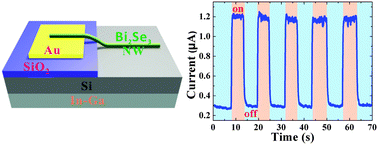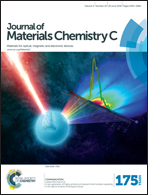Topological insulator Bi2Se3 nanowire/Si heterostructure photodetectors with ultrahigh responsivity and broadband response†
Abstract
Owing to the unique properties of nontrivial Dirac cones on the surface and a narrow bandgap in the bulk, topological insulators have become one of the most promising candidates in the construction of novel electronic and photonic devices. Herein, single-crystalline topological insulators of Bi2Se3 nanowires (NWs) were synthesized via a Au-catalyzed vapor–liquid–solid (VLS) method. Through the transfer of the Bi2Se3 NWs onto a pre-patterned SiO2/Si substrate, Bi2Se3 NW/Si heterostructure photodetectors were fabricated for the first time. The photodetectors exhibited excellent detection performance with an optimized responsivity of ∼103 A W−1 and a broad spectral range from 380 to 1310 nm. The responsivity is significantly better than previous reports and represents the highest value for topological insulator-based photodetectors. The high-crystal quality of the Bi2Se3 NWs, along with the high built-in electric field at the heterostructure interface, is responsible for the excellent performance of the Bi2Se3 NW/Si heterostructure photodetectors. Given the ultrahigh light responsivity, high-speed and broadband response properties, the Bi2Se3 NW/Si heterostructure will have important applications in new-generation optoelectronic devices.


 Please wait while we load your content...
Please wait while we load your content...